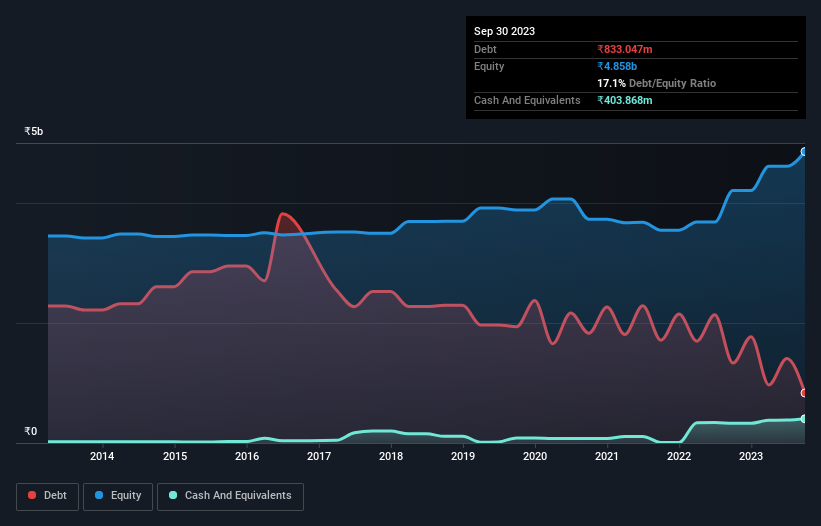
Warren Buffett famously said, 'Volatility is far from synonymous with risk.' It's only natural to consider a company's balance sheet when you examine how risky it is, since debt is often involved when a business collapses. We can see that TAJGVK Hotels & Resorts Limited (NSE:TAJGVK) does use debt in its business. But should shareholders be worried about its use of debt?
What Risk Does Debt Bring?
Debt assists a business until the business has trouble paying it off, either with new capital or with free cash flow. If things get really bad, the lenders can take control of the business. However, a more usual (but still expensive) situation is where a company must dilute shareholders at a cheap share price simply to get debt under control. Of course, plenty of companies use debt to fund growth, without any negative consequences. The first step when considering a company's debt levels is to consider its cash and debt together.
See our latest analysis for TAJGVK Hotels & Resorts
What Is TAJGVK Hotels & Resorts's Debt?
You can click the graphic below for the historical numbers, but it shows that TAJGVK Hotels & Resorts had ₹833.0m of debt in September 2023, down from ₹1.33b, one year before. However, it also had ₹403.9m in cash, and so its net debt is ₹429.2m.

How Healthy Is TAJGVK Hotels & Resorts' Balance Sheet?
According to the last reported balance sheet, TAJGVK Hotels & Resorts had liabilities of ₹1.34b due within 12 months, and liabilities of ₹1.55b due beyond 12 months. On the other hand, it had cash of ₹403.9m and ₹286.8m worth of receivables due within a year. So its liabilities total ₹2.20b more than the combination of its cash and short-term receivables.
Since publicly traded TAJGVK Hotels & Resorts shares are worth a total of ₹19.4b, it seems unlikely that this level of liabilities would be a major threat. But there are sufficient liabilities that we would certainly recommend shareholders continue to monitor the balance sheet, going forward.
We use two main ratios to inform us about debt levels relative to earnings. The first is net debt divided by earnings before interest, tax, depreciation, and amortization (EBITDA), while the second is how many times its earnings before interest and tax (EBIT) covers its interest expense (or its interest cover, for short). This way, we consider both the absolute quantum of the debt, as well as the interest rates paid on it.
With net debt sitting at just 0.40 times EBITDA, TAJGVK Hotels & Resorts is arguably pretty conservatively geared. And this view is supported by the solid interest coverage, with EBIT coming in at 7.6 times the interest expense over the last year. On the other hand, TAJGVK Hotels & Resorts's EBIT dived 17%, over the last year. If that rate of decline in earnings continues, the company could find itself in a tight spot. The balance sheet is clearly the area to focus on when you are analysing debt. But you can't view debt in total isolation; since TAJGVK Hotels & Resorts will need earnings to service that debt. So when considering debt, it's definitely worth looking at the earnings trend. Click here for an interactive snapshot.
Finally, while the tax-man may adore accounting profits, lenders only accept cold hard cash. So it's worth checking how much of that EBIT is backed by free cash flow. Over the most recent three years, TAJGVK Hotels & Resorts recorded free cash flow worth 79% of its EBIT, which is around normal, given free cash flow excludes interest and tax. This free cash flow puts the company in a good position to pay down debt, when appropriate.
Our View
The good news is that TAJGVK Hotels & Resorts's demonstrated ability to convert EBIT to free cash flow delights us like a fluffy puppy does a toddler. But we must concede we find its EBIT growth rate has the opposite effect. All these things considered, it appears that TAJGVK Hotels & Resorts can comfortably handle its current debt levels. On the plus side, this leverage can boost shareholder returns, but the potential downside is more risk of loss, so it's worth monitoring the balance sheet. When analysing debt levels, the balance sheet is the obvious place to start. However, not all investment risk resides within the balance sheet - far from it. Be aware that TAJGVK Hotels & Resorts is showing 1 warning sign in our investment analysis , you should know about...
Of course, if you're the type of investor who prefers buying stocks without the burden of debt, then don't hesitate to discover our exclusive list of net cash growth stocks, today.
Valuation is complex, but we're here to simplify it.
Discover if TAJGVK Hotels & Resorts might be undervalued or overvalued with our detailed analysis, featuring fair value estimates, potential risks, dividends, insider trades, and its financial condition.
Access Free AnalysisHave feedback on this article? Concerned about the content? Get in touch with us directly. Alternatively, email editorial-team (at) simplywallst.com.
This article by Simply Wall St is general in nature. We provide commentary based on historical data and analyst forecasts only using an unbiased methodology and our articles are not intended to be financial advice. It does not constitute a recommendation to buy or sell any stock, and does not take account of your objectives, or your financial situation. We aim to bring you long-term focused analysis driven by fundamental data. Note that our analysis may not factor in the latest price-sensitive company announcements or qualitative material. Simply Wall St has no position in any stocks mentioned.
About NSEI:TAJGVK
TAJGVK Hotels & Resorts
Engages in the business of owning, operating, and managing hotels, palaces, and resorts under the TAJ brand in India.
Flawless balance sheet with proven track record and pays a dividend.
Similar Companies
Market Insights
Community Narratives



